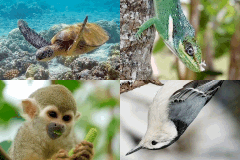AnAge entry for Saimiri sciureus
Classification (HAGRID: 02343)
- Taxonomy
-
Kingdom: Animalia
Phylum: Chordata
Class: Mammalia (Taxon entry)
Order: Primates (Taxon entry)
Family: Cebidae
Genus: Saimiri
- Species
- Saimiri sciureus
- Common name
- South American squirrel monkey
- Synonyms
- Simia apedia, Lemur leucopsis, Simia morta, Chrysothrix nigrivittata, Sapajou saimiri, Saimiri sciureus sciureus
Lifespan, ageing, and relevant traits
- Maximum longevity
- 30.2 years (captivity)
- Source
- ref. 671
- Sample size
- Large
- Data quality
- High
- Observations
One hybrid between a common and a Bolivian squirrel monkey lived 32 years [0671].
Life history traits (averages)
- No information is available on life history. Please contact us if you wish to suggest or contribute data.
Metabolism
- Typical body temperature
- 311ºK or 38.0ºC or 100.4ºF
- Basal metabolic rate
- 4.4290 W
- Body mass
- 836.7 g
- Metabolic rate per body mass
- 0.005293 W/g
References
- [1236] Didier et al. (2016), Contributions of Nonhuman Primates to Research on Aging (PubMed)
- [1136] Gomes et al. (2011), Comparative biology of mammalian telomeres: hypotheses on ancestral states and the roles of telomeres in longevity determination (PubMed)
- [0826] Qin et al. (2006), Calorie restriction attenuates Alzheimer's disease type brain amyloidosis in Squirrel monkeys (Saimiri sciureus) (PubMed)
- [0671] Richard Weigl (2005), Longevity of Mammals in Captivity; from the Living Collections of the World
- [0192] McCormack et al. (2004), Aging of the nigrostriatal system in the squirrel monkey (PubMed)
- [0036] Savage et al. (2004), The predominance of quarter-power scaling in biology
- [0193] Brady et al. (2003), Studies of heart disease and failure in aged female squirrel monkeys (Saimiri sp.) (PubMed)
- [0420] White and Seymour (2003), Mammalian basal metabolic rate is proportional to body mass2/3 (PubMed)
- [0108] Steinert et al. (2002), Telomere biology and cellular aging in nonhuman primate cells (PubMed)
- [0467] Lindenfors (2002), Sexually antagonistic selection on primate size
- [0434] Ronald Nowak (1999), Walker's Mammals of the World
- [0463] Austad (1997), Small nonhuman primates as potential models of human aging (PubMed)
- [0388] Ghilardi et al. (1996), Intra-arterial infusion of [125I]A beta 1-40 labels amyloid deposits in the aged primate brain in vivo (PubMed)
- [0455] Virginia Hayssen et al. (1993), Asdell's Patterns of Mammalian Reproduction: A Compendium of Species-Specific Data
- [0390] Ingram et al. (1990), Dietary restriction and aging: the initiation of a primate study (PubMed)
- [0389] Walker et al. (1990), Amyloid in the brains of aged squirrel monkeys (PubMed)
- [0075] Selkoe et al. (1987), Conservation of brain amyloid proteins in aged mammals and humans with Alzheimer's disease (PubMed)
- [0731] Zullinger et al. (1984), Fitting sigmoid equations to mammalian growth curves
- [0059] Tolmasoff et al. (1980), Superoxide dismutase: correlation with life-span and specific metabolic rate in primate species (PubMed)
- [0436] Cutler (1979), Evolution of human longevity: a critical overview (PubMed)
External Resources
- Integrated Taxonomic Information System
- ITIS 180095
- Animal Diversity Web
- ADW account
- Encyclopaedia of Life
- Search EOL
- NCBI Taxonomy
- Taxonomy ID 9521
- Entrez
- Search all databases
- Ageing Literature
- Search Google Scholar or Search PubMed
- Images
- Google Image search
- Internet
- Search Google

